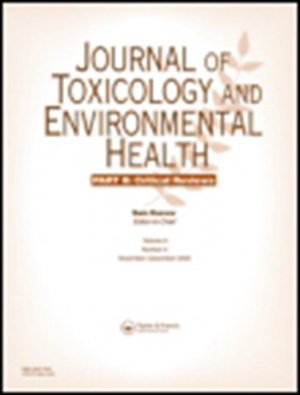锂离子电池爆炸风险评估:化学物质泄漏。
IF 6.4
2区 医学
Q1 ENVIRONMENTAL SCIENCES
Journal of Toxicology and Environmental Health-Part B-Critical Reviews
Pub Date : 2018-01-01
Epub Date: 2019-04-12
DOI:10.1080/10937404.2019.1601815
引用次数: 23
摘要
锂离子电池的使用引发了化学物质泄漏、过度充电、外部加热或爆炸等安全问题。对锂离子电池可能泄漏的氢氟酸(HF)和氢氧化锂(LiOH)进行了风险评估。HF吸入无观察到不良反应水平(NOAEL)为0.75 mg/kg/d。当锂离子电池在有限的空间内爆炸时,HF的排放量为10-100 ppm。在最坏情况下,计算出的转化率为81.8 mg/m3,平均日剂量(ADD)为19.5 mg/kg/d。因此,暴露边际(MOE = NOAEL/ADD)为0.034,该值构成不安全的HF吸入暴露。相反,LiOH的皮肤毒性NOAEL为41.35 mg/kg/d-。这个LiOH值反映了锂离子电池中锂的含量,锂是在水和电解质接触时产生的。手机中的锂含量约为295毫克,系统暴露剂量(SED)为4.92毫克/千克/天。因此,MOE (NOAEL/SED)值为8.41,认为皮肤暴露于LiOH对人体是安全的。然而,重要的是,储能系统电池仍然需要下一代电池的安全措施和技术,以防止锂离子电池的任何潜在爆炸。本文章由计算机程序翻译,如有差异,请以英文原文为准。
Risk assessment of lithium-ion battery explosion: chemical leakages.
ABSTRACT Use of lithium-ion batteries has raised safety issues owing to chemical leakages, overcharging, external heating, or explosions. A risk assessment was conducted for hydrofluoric acid (HF) and lithium hydroxide (LiOH) which potential might leak from lithium-ion batteries. The inhalation no-observed-adverse-effect-level (NOAEL) for HF was 0.75 mg/kg/d. When a lithium-ion battery explodes in a limited space, HF emissions amount to 10–100 ppm. Assuming the worst-case scenario, the conversion rate was calculated to be 81.8 mg/m3, and the average daily dose (ADD) was 19.5 mg/kg/d. Consequently, the margin of exposure (MOE = NOAEL/ADD) was 0.034, a value which constitutes an unsafe inhalation exposure for HF. Conversely, skin toxicity NOAEL for LiOH was 41.35 mg/kg/d−. This LiOH value reflects the amount of lithium in the lithium-ion battery, which is generated upon contact between water and the electrolyte. The quantity of lithium in a mobile phone is approximately 295 mg, and systemic exposure dose (SED) was 4.92 mg/kg/d. Accordingly, the MOE (NOAEL/SED) value was 8.41, and skin exposure of LiOH was deemed as safe for humans. However, it is important that Energy Storage System batteries still require safety measures and technologies for next-generation batteries, to prevent any potential explosions of lithium-ion batteries.
求助全文
通过发布文献求助,成功后即可免费获取论文全文。
去求助
来源期刊
CiteScore
13.80
自引率
6.90%
发文量
13
审稿时长
>24 weeks
期刊介绍:
"Journal of Toxicology and Environmental Health: Part B - Critical Reviews" is an academic journal published by Taylor & Francis, focusing on the critical examination of research in the areas of environmental exposure and population health. With an ISSN identifier of 1093-7404, this journal has established itself as a significant source of scholarly content in the field of toxicology and environmental health.
Since its inception, the journal has published over 424 articles that have garnered 35,097 citations, reflecting its impact and relevance in the scientific community. Known for its comprehensive reviews, the journal also goes by the names "Critical Reviews" and "Journal of Toxicology & Environmental Health, Part B, Critical Reviews."
The journal's mission is to provide a platform for in-depth analysis and critical discussion of the latest findings in toxicology, environmental health, and related disciplines. By doing so, it contributes to the advancement of knowledge and understanding of the complex interactions between environmental factors and human health, aiding in the development of strategies to protect and improve public health.

 求助内容:
求助内容: 应助结果提醒方式:
应助结果提醒方式:


